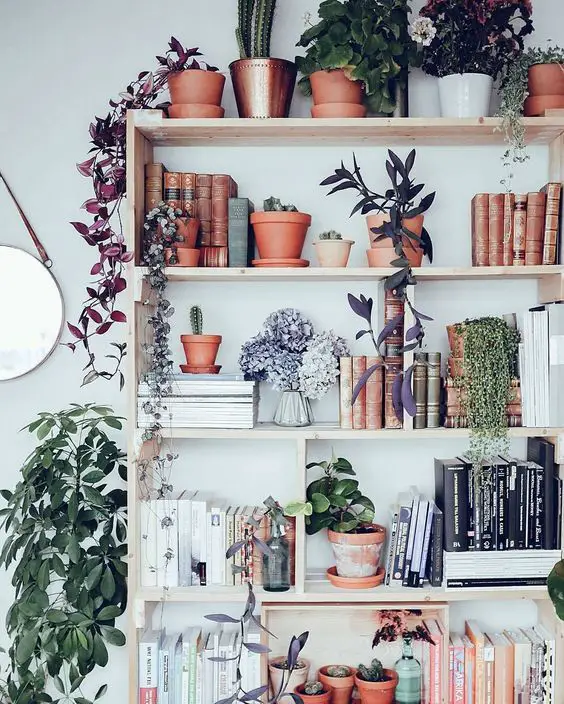This post may contain affiliate links. If you click the links, we may earn a small commission at no additional cost to you! Learn more on our privacy policy page.
Placing live plants on a bookshelf may appear simple in theory, but doing it thoughtfully and purposefully might not be as easy. Read further to check out the best plant placement ideas and how to implement them into your bookshelf.
When striving to transform an everyday bookshelf into a beautiful green-filled image, there are various factors to consider, ranging from the precise species of plants, the planter pots in which to display them, as well as their best placements.
If you’re confused about how to position your potted greens on your shelf, you’re in the right place. This article enumerates some excellent plant placements for your bookshelf, so keep reading to learn more!

Table of Contents
Importance of Light

The quantity of light your bookshelf receives is critical for successful plant placement.
Shelves, especially bookcases, are frequently situated away from windows and out of direct sunlight, making it hard for plants to grow.
Lower shelves might also be dimmer than shelves that are higher, parallel to windows, or more open. That said, if you have a higher bookshelf, a skylight would provide extra light to it.
To evaluate the lighting on a shelf, check if your hand casts any shadows when you place it near the bookcase. Also, inspect your plants for indications of stress, like yellowing leaves, scale, or mealy bugs.
If you’re unable to transfer the shelves to a more adequately lit area, consider switching your plants such that they spend a brief period on the shelves before being returned to a better-lit spot.
Rotate Your Plants
Since behind your bookshelf will be dark, you need to rotate plants exposed to intense light so that every part of your plant receives adequate lighting.
Every week, rotate each plant around 90 degrees.
Another alternative for bookshelves that don’t have good access to sunlight is to choose foliage that can thrive in that type of environment. That way, you won’t be forced to continually place it near a window.
When I first started my indoor gardening journey, I realized my shelves were too high for my window. So, I opted for some greenery that could thrive in the dark like Peace Lily, Philodendrons, and Spider plants. The peace lily is a personal favorite. Its stunning white flowers provide beauty to dark places.

How to Place Your Plants
Now that you’re all caught up on lighting requirements, here are some excellent ways to place your plants on your bookshelf:

Rule of Threes
Styling your potted greens in groups of three will improve the appearance of your shelves.

Even though there isn’t much room between your books and plants, arranging them in small groups can help you pick which plant looks most suitable next to which object.
Mix & Match
Using a variety of species will ensure that you have a plant shelf that you will enjoy for a long time.
Different species will produce a range of colors, shapes, patterns, and sizes, ensuring that your leafy arrangement is a visually appealing addition to your home.

Make a Trail
Trailing plants are perfect for displaying on shelves since they have the freedom to grow as much as they wish.
Adding them to your mix of indoor greenery can give your residence a wonderful natural vibe.
Place your trailing plants at the top of your bookshelf so that they can trail downwards.
I’ve found Devil’s ivy to be an easy plant to grow inside the house.
Just place it at the end of your shelf and watch as it drapes beautifully down the side.
You can tie your trailing vine loosely around the sturdy legs of an open-concept bookshelf.

Create Layers With Ornamental Items and Plant-Related Tools
Search around your house for available items to provide a new dimension.
You can display your assortment of empty, appealing vases/pots on your bookshelves.
You could also place your visually appealing mister or watering can above a pile of relevant plant books.
If your bookshelf is white, consider stacking colorful books beside or underneath your potted greenery.
You can also try purchasing some colorful flowerpots to add splashes of color to the room. This adds to the warmth of the space as well.

Think About Size and Scale
Greenery comes in a variety of forms and sizes, so playing with sizes doesn’t have to be intimidating.
You can experiment with different plant heights to discover the optimum arrangement for your shelves.
Place larger plants at the ends of your bookshelf to anchor the style.
Place tall greens beside smaller, wider ones.
Alternatively, you can stack some books horizontally to serve as a platform for a lovely potted plant.
Avoid putting plant pots with drainage holes on top of any books; water could leak through and ruin the cover and contents.
Sometimes the very top of a bookshelf is the best place for a plant. Some plants’ growth structures may not allow them to be confined by an above-the-ground shelf.
And, some plants grow upwards. So, you can exhibit them for only a few months on your shelf.
Instead, consider placing these at the top of the shelf for unrestricted growing areas.
Safety Tips
Watch out for curious dogs and young children. Place your pots far out of their reach, especially if the plants are poisonous or toxic for consumption.
Also, remove any adjacent ladders or easily movable furnishings your dogs or kids can climb.
Keep non-fragile objects on lower shelves.
In addition, you can use museum wax to keep specific items in place. You can also bolt/mount the bookshelf itself firmly to the wall to prevent anyone from climbing or crashing into it.
If you’re worried that your pets or kids might still accidentally break your pots, regardless of all your safety measures, I recommend you get some plastic pots.
Lastly, consider watering your plants over a sink to prevent slippery falls. I learned that the hard way.
In Conclusion
Properly placing your plants on your bookshelf doesn’t have to be a complicated affair.
Once you’ve got your plant’s lighting needs covered, follow any of the methods outlined above to give your dwelling place a beautiful and elegant look.
Whether you place your potted greens together on your bookshelf in groups of threes, alternate the sizes and colors, or make them trail downwards along your bookshelf, each arrangement is sure to add elegance, beauty, and lushness to your home.


Out of all the tips I like making a trail the most